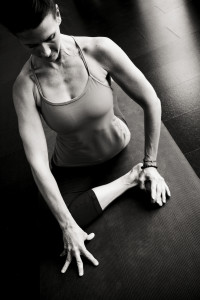Refine your practice: understanding sthira and sukha
Explore yoga’s “yin and yang” concept the next time you’re on the mat
One of the fundamental concepts behind good yoga practice comes from the Yoga Sutras of Patanjali, a source text for many of today’s popular styles of yoga. In the Yoga Sutras, the sage Patanjali defines the physical postures of yoga (called yoga asana) this way: Sthira sukham asanam (2.46), which is commonly translated from Sanskrit to read “Asana is a steady, comfortable posture.
 ”In other words, every yoga pose should be done with the qualities of both steadiness (sthira) and comfort (sukha), effort and ease. The esteemed yoga teacher and scholar TKV Desikachar adds a few more helpful words to the interpretation, advising that our asana practice should have both alertness without tension and relaxation without dullness.
”In other words, every yoga pose should be done with the qualities of both steadiness (sthira) and comfort (sukha), effort and ease. The esteemed yoga teacher and scholar TKV Desikachar adds a few more helpful words to the interpretation, advising that our asana practice should have both alertness without tension and relaxation without dullness.
The concept sounds simple enough—until you consider your last practice. Of the time you spent on the mat, how much of it would you say you spent in a state of both alertness without tension and relaxation without dullness? Trust us—you’re not alone if you’d rather not say, or if you have no earthly idea.
Why it’s important
But why is this concept important? Consistently cultivating and maintaining both ease and effort in a yoga posture requires focused attention and also the ability to make precise, sometimes very subtle adjustments in your body—as well as in your mind. This kind of focused attention of both mind and body is what generates the transformative aspects of yoga—that’s the real source of that post-savasana ahhhhh. It requires us to step out of our usual mode of moving, breathing, and thinking — whatever they might be.
If we bring our “go big or go home” attitude to the mat or we seek to chaturanga our way to a more beautiful body, we are likely to miss the opportunity to find harmony with our body as it is, not as we wish it to be (not to mention, we increase our risk of injury about a millionfold). In the same way, if we’re so comfy in our practice that we pay more attention to the teacher’s awesome playlist than to our foot placement, or our thoughts wander off with the mind’s latest tasty or troubling distraction, we’re missing an opportunity for self study and transformation (and, again, we put ourselves at increased risk for injury).
See what there is to see
So how do you know whether or not you’ve got your sthira and sukha in all the right places? Next time you come into a yoga pose, take a beat; let your awareness take a step back and, without over-analyzing, observe what’s happening in your system. Are you breathing, and what is the quality of your breath? Do you feel tension or excessive effort building up somewhere in your body—or in your mood? Or, has your brain disengaged from your body and you’re actually thinking about your teacher’s asana, the breathing of the person on the mat next to yours, or what you’ll do after class? These are all signs that something about your asana may be a bit too sthira, or too sukha.
And when you do notice these things, congratulate yourself: you’ve just come back to the present moment! And you have created the opportunity to regroup, take a breath, and come back to a steady, comfortable pose.
That’s the yoga kicking in.
Does a particular pose always push your buttons or get you stuck in a rut? Check out Carrington’s upcoming posture clinic, Refine Your Asana, July 20, 2014.
